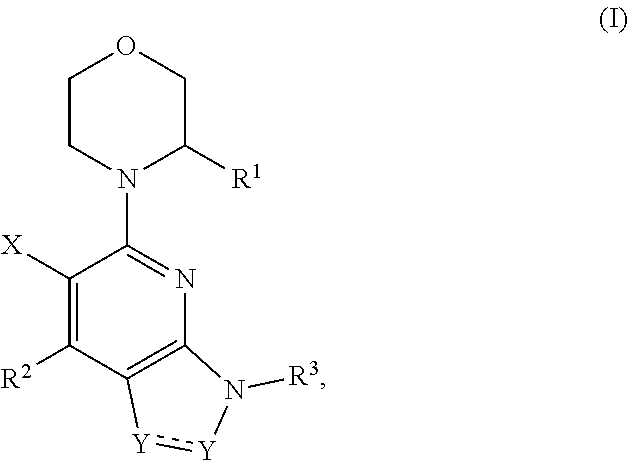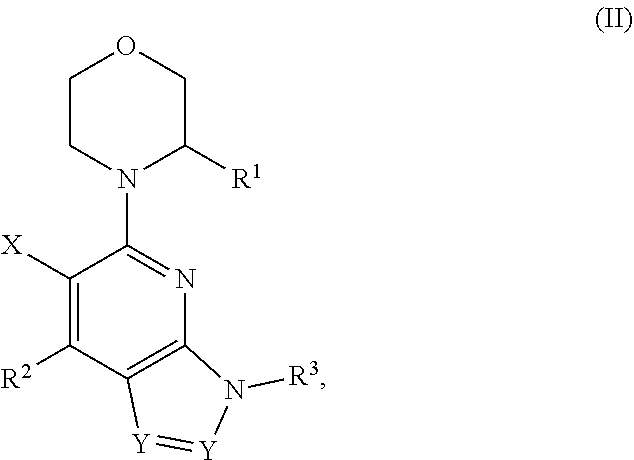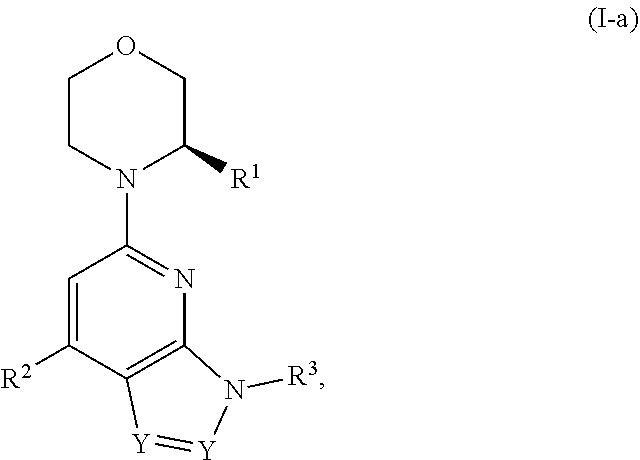Compounds, pharmaceutical compositions, and methods of preparing compounds and of their use as atr kinase inhibitors
a technology of atr kinase inhibitor and compound, which is applied in the field of compound, pharmaceutical composition, and methods of preparing compound and their use as atr kinase inhibitors, can solve the problems of deficient mice being embryonic lethal, cancer cells being subject to a higher rate of dna damage inherently induced,
- Summary
- Abstract
- Description
- Claims
- Application Information
AI Technical Summary
Benefits of technology
Problems solved by technology
Method used
Image
Examples
example 1
on of Compounds
[0507]Compound 1
[0508]Step 1. A suspension of 4-chloro-7-azaindole (25 g) in DMA (140 mL) was purged with vacuum / N2 gas (3 cycles). Zinc powder (1.07 g), zinc cyanide (11.26 g), dppf (2.72 g) and Pd2(dba)3 (2.39 g) were then added. The mixture was purged again with vacuum / N2 gas (3 cycles) and heated to 120° C. for 4 h. The reaction mixture was allowed to cool down to 100° C. and water (428 mL) was added over 30 min. The mixture was then cooled to rt over 2 h. The crude product was filtered and washed with water (2×95 mL), then added to 3 N HCl (150 mL) and the mixture was stirred at rt for 2 h. The insolubles were removed by filtration. To the filtrate was added 50% aq. NaOH until pH 12 was reached. Filtration and drying afforded 1H-pyrrolo[2,3-b]pyridine-4-carbonitrile (11.6 g) as a tan solid.
[0509]Step 2. A mixture of 1H-pyrrolo[2,3-b]pyridine-4-carbonitrile (10.4 g) and NaOH (29 g) in water (100 mL) and EtOH (100 mL) was heated to reflux for 18 h. Upon cooling to ...
example 2
Enzymatic Assay
[0624]Detection of ATR kinase activity utilized the AlphaScreen system to measure the phosphorylation of the substrate protein p53. Recombinant purified ATR / ATRIP (Eurofins cat #14-953) at a final concentration of 0.63 nM in assay buffer (50 mM Hepes pH 7.4, 0.1 mM vanadate, 0.5 mM DTT, 0.1 mM EGTA, 5 mM MnCl2, 0.01% Brij-30, 1% glycerol, 0.05% BSA) was mixed with compound serially diluted in 10% DMSO. The final DMSO concentration was 1.25%. A pre-mix of GST-tagged p53 (full length, Enzo Life Sciences cat # BML-FW9370) and adenosine 5′-triphosphate, ATP (Sigma-Aldrich cat #10519979001, Roche Diagnostic) in assay buffer was added to the enzyme:compound mix for a final concentration of 25 nM GST-p53 and 3 μM ATP. The reaction was allowed to proceed at room temperature for 1 hour then stopped by the addition of a pre-mix of phospho-p53 (Ser 15) antibody (New England Biolabs cat #9284S) at 1:3000 final dilution, 14.3 pg / mL glutathione donor beads (PerkinElmer Life Science...
example 3
in Hela Cells
[0625]HeLa S3 cells were plated in 384-plate format at a density of 16K cells per 25 μL well in regular media F-12K 10% FBS and incubated overnight at 37° C. 1-5% CO2. Media was then replaced by 20 μL per well Opti-MEM no phenol red and 5 μL of serial diluted compounds were added to the assay plate for a final DMSO concentration of 0.5%. Cells and compounds were incubated at room temperature for 20 minutes before addition of 5 μL of gemcitabine at a final concentration of 1.5 μM. The plate was incubated at 37° C., 1-5% CO2 for 3.5 to 4 hours. The media was removed and the cells were lysed in 15 μL of PerkinElmer lysis buffer for 10-20 min; 4 μL of lysates were then transferred to proxi white plate 384-format ((PerkinElmer Life Sciences cat #6008280). Quantification of CHK1 phosphorylation at Ser345 was done using Alphascreen SureFire CHK1 p-Ser345 (PerkinElmer Life Sciences cat # TGRCHK1S1 OK) and Alphascreen protein A. (PerkinElmer Life Sciences cat #67060617C). The pl...
PUM
| Property | Measurement | Unit |
|---|---|---|
| Volume | aaaaa | aaaaa |
| Mass | aaaaa | aaaaa |
| Mass | aaaaa | aaaaa |
Abstract
Description
Claims
Application Information
 Login to View More
Login to View More - R&D
- Intellectual Property
- Life Sciences
- Materials
- Tech Scout
- Unparalleled Data Quality
- Higher Quality Content
- 60% Fewer Hallucinations
Browse by: Latest US Patents, China's latest patents, Technical Efficacy Thesaurus, Application Domain, Technology Topic, Popular Technical Reports.
© 2025 PatSnap. All rights reserved.Legal|Privacy policy|Modern Slavery Act Transparency Statement|Sitemap|About US| Contact US: help@patsnap.com



